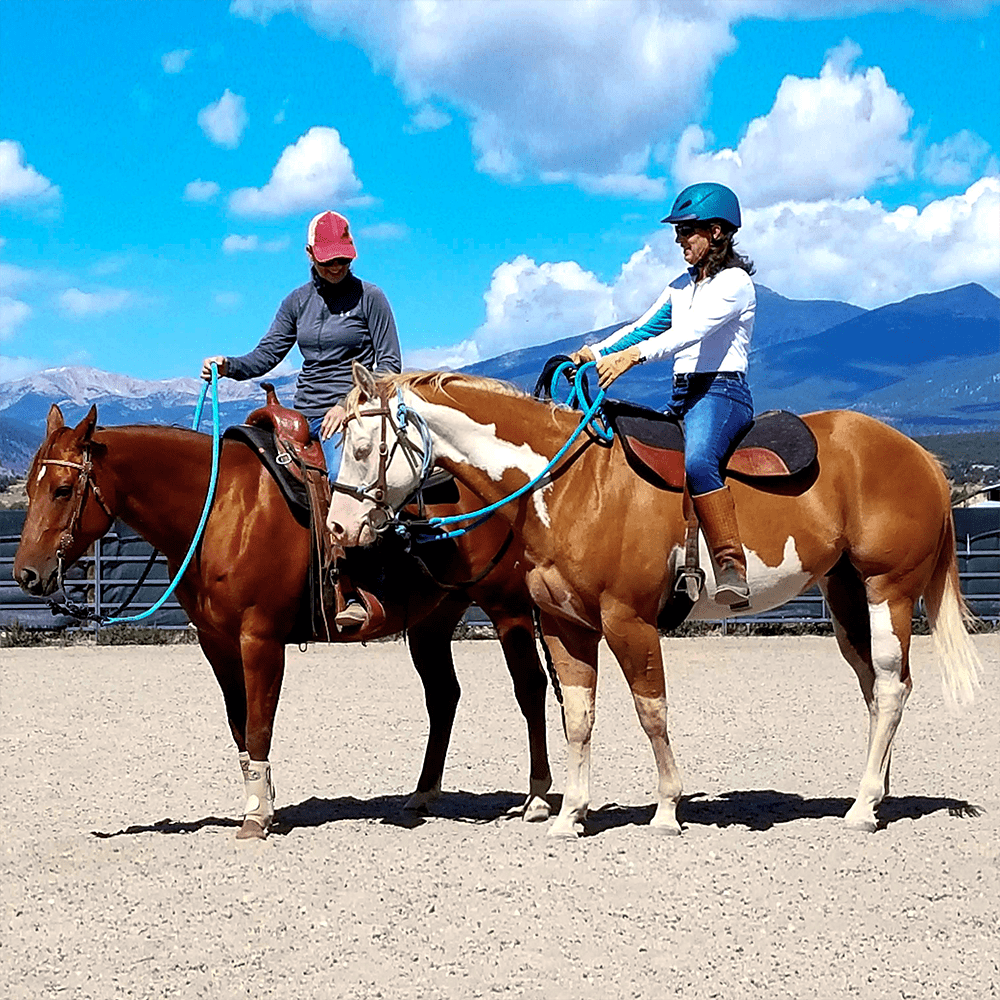Question: Dear Julie:
I have a silly question…My mare is 15yo and I have NEVER used a rope halter. Do you have a basic do’s and don’ts for me….things I need to know to help me better understand how it works?
Answer:
I wish more people would ask simple questions like this– it’s not silly but smart! When people stop and think about what they fundamentally know (or more likely, what they do not know) they generally get a lot farther with horses. There is a lot to know about using rope halters, how they work, how they should fit and when to use them (and when NOT to use them).
I think of rope halters as a training aid—it is a way to apply enough pressure on the horse’s face to get his attention and/or gain control. It is a far superior tool, in my opinion and experience, than using a stud chain on a horse for control because you can finesse the pressure with a rope halter. A stud chain will put constant pressure on the horse—you can make the pressure worse but you can never totally release it. With the rope halter, there is only pressure when you manipulate the lead rope, so you have more training ability and finesse. But all rope halters are not created equally!
A rope halter can be harsh or mild, depending on the diameter of the rope (thinner is harsher) and the number of knots on the noseband (more knots create more pressure). While a narrow diameter halter with added knots may be more expedient on the more difficult horses, it is not necessary (or advantageous) for all horses. I prefer to use a thicker diameter (3/8 inch) stiff rope for my halters and the minimum number of knots to make it a halter. I’ve yet to meet a horse that wouldn’t respond to this amount of pressure and there are many horses for which too much pressure can cause the horse to have a met-down rather than think his way through the problem. The thicker diameter is mild enough for everyday use and not just as an aid when you are actively engaged in ground training.
Contrary to popular belief, the knots in a rope halter are not placed to take advantage of pressure points on the horse’s face—they are put where they need to be to make it a halter—exactly where the hardware is in a flat halter. However, the knots do focalize the pressure and when you snap or jiggle the lead rope, the horse feels more pressure than he would in a flat halter.
For ground work, I prefer to use a rope halter (my halters are specially designed for comfort, fit and effectiveness) and a long training lead—12 or 15 feet. I do not have metal buckles on my training leads because when I snap the rope, the chin knot will bump the horse in the chin (that is the pressure he feels when he is doing something wrong) and a metal buckle hitting the chin can be too much pressure for many horses (and they become afraid of the correction and quit thinking). To me it is critical that the training lead be made of the highest quality marine rope that is soft in your hands and heavy enough to have good feel so that you can make subtle movements with the rope and impact your horse.
The rope halter should always be adjusted correctly and make sure you learn how to tie the halter knot right. At the start of every ground work clinic that I do, I spend a few moments adjusting halters and retying the knots correctly on most of the horses in the clinic. A rope halter that hangs too low can really hurt a horse’s nose and if the noseband were to sag so much that the horse could get a foot in, it could really hurt your horse. Check out this link on my website that explains rope halter fit and how to tie knots correctly: Rope Halter Instructions
As for the DONT’S: never turn a horse loose in a rope halter. For that matter, I wouldn’t turn a horse out in any halter but definitely not a rope halter. Generally they are made of high-tensile rope that will not break; a horse turned loose in a rope halter could catch it on something and panic and get hurt. For the same reason, I would never tie a horse in a trailer in a rope halter. You know he will get off balance at times and end up pulling on the halter—I don’t want him to have too much pressure on his face, just because he got off balance. Plus, in the trailer the horse should be outfitted in a break away halter in case of an emergency. In the trailer I want him to be safe and comfortable, so I’ll use a leather halter with sheepskin lining. Don’t use a rope halter that’s too snug—there will be constant pressure on his face so you lose the ability to release the pressure. Don’t use one that’s too big either; the noseband should not be so large that the horse could get it caught on something like his foot.
Tying a horse in a rope halter can be good training or can cause a problem if you have a horse that has a pull-back issue. We tie all our yearlings and older in a rope halter as they are learning to stand tied quietly. They learn not to pull on it because they’ll feel pressure every time they do. But if you have a horse that is already a chronic panic puller, the rope halter may make him worse by increasing his panic and fear when he pulls.
An important thing to know before you invest in a rope halter is that all ropes are not created equally and all halters are not tied correctly. With rope, you get what you pay for. Really high-quality rope that does not stretch out or break and works well in your hands is more expensive. You may have already figured this out with cheap lead ropes that break and burn your hands. Also, if not made correctly, the proportions of the halter can be off so that it never quite fits your horse’s face right—I see this a lot with home-made rope halters. As with most equipment that you buy for horses, it is best to stay away from the really cheap stuff.
Of course, the real benefit from rope halters is in the training techniques you use ot teach your horse obedience and ground manners. Once you invest in a good rope halter and training lead, use my video, Leadline Leadership, to learn specific training techniques and exercises to teach your horse to stand quietly, walk and trot off your body cues, back, circle and change directions so that he becomes focused on you as his leader. Rope Halter Instructions
Thanks for asking a great question!
Julie
Copyright ©Julie Goodnight 2000. All Rights Reserved. No part of this website may be reproduced without owner’s express consent.
Lorem ipsum dolor sit amet, consectetur adipiscing elit. Ut elit tellus, luctus nec ullamcorper mattis, pulvinar dapibus leo.

